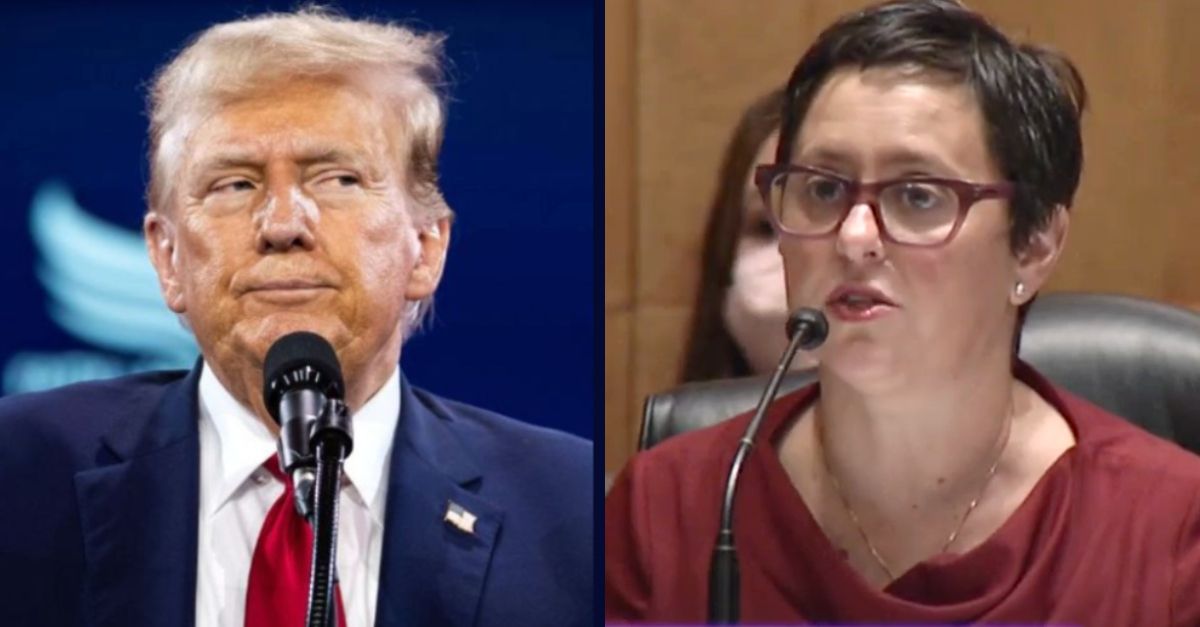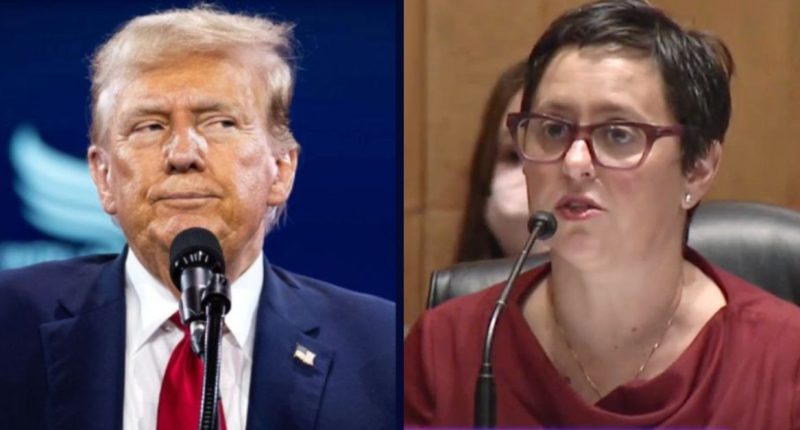
Left: Donald Trump speaks at the annual Road to Majority conference in Washington, DC, in June 2024 (Allison Bailey/NurPhoto via AP). Right: Cathy Harris speaking at a Senate HSGAC Committee nominations hearing on Sept. 21, 2021, to become member and chair of the Merit Systems Protection Board (Sen. James Lankford/YouTube).
A federal appeals court will leave in place an earlier ruling allowing the president to terminate the head of a board that reviews firings of federal employees after the Justice Department argued that staying its order would effectively disenfranchise those who voted for President Donald Trump.
A three-judge panel on the U.S. Circuit Court for the District of Columbia had previously rejected a request to stay its decision allowing President Trump to fire Cathy A. Harris from the Merit Systems Protection Board (MSPB). Mirroring the appellate panel’s Friday tally, the judges voted 2-1 in rejecting a request to stay its Friday decision, which granted a stay of a lower court’s order that required Harris be returned to her role on the board.
U.S. Circuit Judge Justin Walker, a Trump appointee, and U.S. Circuit Judge Karen L. Henderson, an appointee of George H.W. Bush, on Friday both voted in favor of staying the district court’s ruling, while U.S. Circuit Judge Patricia Millett, a Barack Obama appointee, dissented. Harris immediately requested a stay of the appeals court’s order pending her request that the case be presented to the court “en banc,” meaning all of the judges on the circuit.
Walker and Henderson again voted to reject Harris’ request for a stay of the stay while Millett said she would grant the request.
Harris, a Democrat who was nominated to the MSPB by President Joe Biden, was supposed to serve until her term expired in 2028 before she received notice last month that she was “terminated, effective immediately.” Without Harris, the board lacks a quorum, which could hamper its ability to function as the Trump administration continues its sprawling efforts to gut the federal workforce.
“As a panel of this Court explained in Dellinger v. Bessent — when staying an order reinstating another principal executive officer whom the President removed — and as Judge Henderson reiterated in this case, ‘it is impossible to unwind the days during which a President is directed to recognize and work with an agency head whom he has already removed,”” the DOJ’s 12-page filing opposing both Harris’ second stay request and her request for a rehearing en banc states. “Judge Walker similarly recognized that ‘[t]he forcible reinstatement of a presidentially removed principal officer disenfranchises voters by hampering the President’s ability to govern.’”
After being fired on Feb. 10, Harris sued the Trump administration and won her job back through a temporary restraining order and a subsequent permanent injunction, both of which were issued by U.S. District Judge Rudolph Contreras. The government appealed and the three-judge panel voted to stay Contreras’ injunction, allowing Trump to fire both Harris and National Labor Relations Board (NLRB) member Gwynne Wilcox — who had also won reprieve from a politically-motivated firing at the district court level.
The DOJ argues that Trump has the “inherent constitutional authority” to remove Harris and Wilcox, asserting it is well established that “the President’s removal power is the rule, not the exception.”
The administration further claimed that staying the circuit court’s Friday order would risk placing the parties “in a whipsaw.” According to the DOJ, should the administration ultimately win on the merits, any decisions made with the participation of Harris and Wilcox would be “called into question and potentially voidable.”
The appellate panel’s staying of the district court’s order reinstating Harris is particularly vulnerable to being overturned should it be heard by the en banc court, as it appears to conflict with long-standing legal precedent stemming from the U.S. Supreme Court’s 1935 decision in Humphrey’s Executor v. United States, which controls the originating statute that created the MSPB: the Civil Service Reform Act of 1978 (CSRA).
In tandem, the two sources of law have, for decades, been understood to mean that a president can fire a member of an independent agency “only for inefficiency, neglect of duty, or malfeasance in office.” Harris emphatically highlighted that understanding in her request for a stay, accusing the panel of attempting to rewrite Supreme Court precedent by allowing Trump to remove her without cause.
“The panel’s extraordinary order allows the Administration to immediately remove Harris from her position as a neutral arbitrator — something no President has attempted in the modern era — and mars the protection that Congress deemed essential for adjudicators to decide cases without fear or favor,” the filing stated. “The order effectively overturns Humphrey’s Executor and [another decades-old similar case]; defies the Supreme Court’s express instructions in [a recent similar case] that the Humphrey’s Executor framework remains good law; and ‘openly calls into question the constitutionality of dozens of federal statutes conditioning the removal of officials on multimember decision-making bodies.’”
Colin Kalmbacher contributed to this report.
Love true crime? Sign up for our newsletter, The Law&Crime Docket, to get the latest real-life crime stories delivered right to your inbox.






